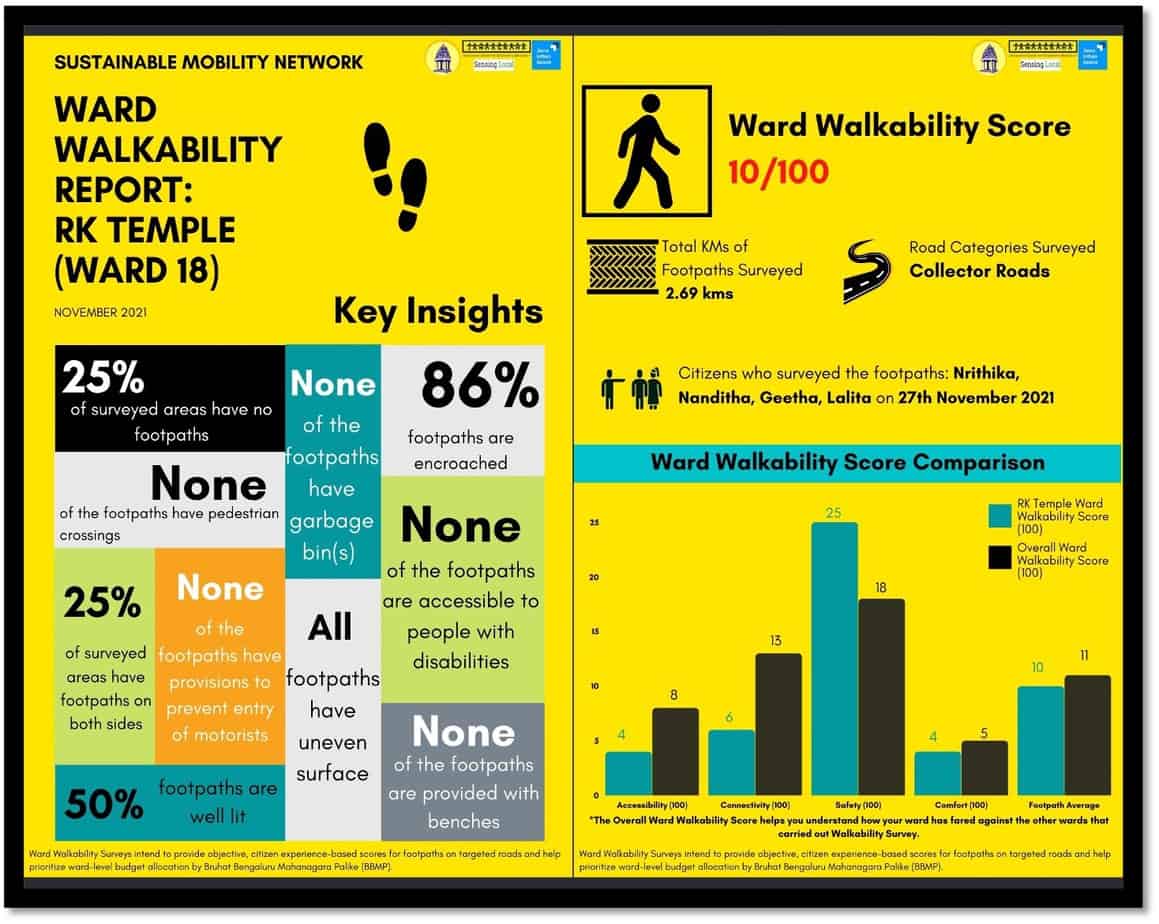I don’t drive a four wheeler. I don’t ride a two wheeler. I don’t even cycle. I WALK everywhere in my neighbourhood, Sanjaynagar, for all my daily needs. Hence I understand the need for good, walkable footpaths. Which are essential to motivate citizens to get off their vehicles and choose to walk, at least short distances.
When I heard about BBMP allocating Rs 20 lakhs to each ward for footpath improvement, where the footpath was to be identified by the ward residents, I was thrilled and looking forward to being a part of this initiative.
But nothing really happened till I got a call from Janaagraha asking if I would like to take this initiative forward in our ward. They will be ready to coordinate and help, they said. I readily agreed. Janaagraha had done a campaign called My City My Budget earlier where they had taken inputs from citizens on how they would want their ward budget to be spent and this was an outcome of that.
Sanjaynagar mainly falls in wards 18 and 19. Citizens of both these wards work closely on most initiatives that happen in this neighbourhood. So we got together with active residents of ward 19 and started working on this improving footpaths campaign.

Read more : Webinar: How ward committees are utilising funds for potholes, footpaths, borewells
The survey, an eye opener
The first step was a presentation by Janagraha for residents of both wards. The presentation consisted of three main points:
- The details and breakup of the budgets allocated.
- How citizens could use their google form and do the survey of footpaths.
- The importance of making this initiative a success.
Rs 20 lakhs may be a small amount and may only cover a very small stretch of footpath. But successful implementation could give BBMP confidence to allocate more funds for citizen driven projects in future.
After the presentation, we formed a group of interested, active citizens and started discussing the different stretches that we could cover as part of the survey. The unanimous first choice was to survey Sanjaynagar main road. This is a commercial road connecting the two wards and extensively used by residents of both.
But then we realised that this road is categorised as a major road and cannot be covered under this budget. We then came up with two criteria for choosing the footpaths.
- There are many schools in Sanjaynagar and many children walk to their schools. So we wanted to choose roads which connect schools to enable students to walk safely and motivate parents to convince their kids to walk to school.
- There are two main roads in Sanjaynagar which residents frequent for all their shopping needs, Sanjaynagar Main Road and New BEL Road. We looked for roads that connect to these commercial roads so that residents can get motivated to walk to do their shopping rather than take their vehicles.
Doing the footpath survey was an eye opener for me. I have walked on these footpaths many times earlier without being conscious of how bad they really were. I had just got used to going around broken pavers, cables lying loose, garbage, construction debris, stepping down on the road and climbing back again where it’s blocked by vendors or parked vehicles, balancing myself while getting on to the footpaths with steep ramps.
When we started noting down every single obstruction, we realised how bad the footpaths actually were. The Janaagraha form also had questions like are the footpaths well lit, do they have tree cover, do they have benches, are they accessible to people with disabilities, do they have bollards to prevent entry of motorists, do they have garbage bins etc.
Wow! Are these even a possibility in footpaths in residential areas? I thought these were luxuries only meant for CBD areas and privileged neighbourhoods. We are quite used to considering our drain covers as footpaths and being happy that we have one.

Now, fingers crossed, we are waiting for the project to take off. This Rs 20 lakhs, and one small footpath stretch, may look insignificant, but success here can hopefully lead to more funds being allocated for citizen driven initiatives. And why not? When revenue comes from taxes paid by citizens and the infrastructure is also used by citizens, should they not have a say in where and how the money is being spent?
I would like to acknowledge Janaagraha’s role in this entire process. We would not have reached this far without Janaagraha coordinating between us and the officials. I am sure all wards have active citizens interested and enthusiastic about such initiatives, but many do not have the connection with the officials to move things. Janaagraha has bridged this gap.
I really wish we see a day when the entire budget for the ward is decided based on inputs from citizens. It should not be just from a few active citizens or whatsapp groups but a proper feedback from a cross section of the population of the ward. It is also important to fix accountability for work not done or executed poorly.
A start has definitely been made with ward committee meetings. Citizens at least have a forum where they can question the authorities. There is a lot of scope for improving the quality of the ward committee meetings. It has to go beyond just grievance redressal. The participation of citizens in these meetings also needs to improve.
Currently, awareness of ward committee meetings is more or less restricted to citizens who are part of ward whatsapp groups. Effective ward committee meetings with participation from all sections, can become a game changer.
Change is a slow process. But it is inevitable if more and more citizens think that they want change and are ready to participate in the process.

It would be relevant to read how this initiative progresses to the next level.